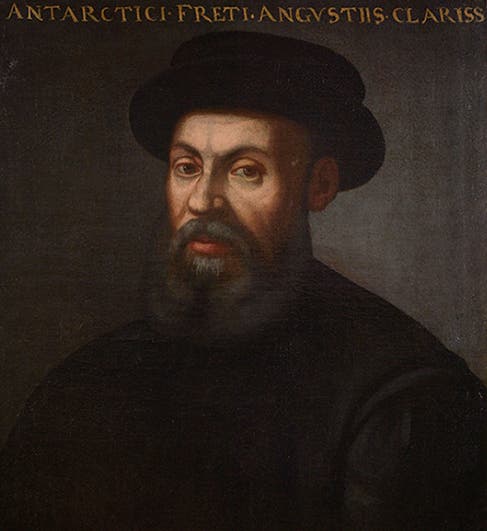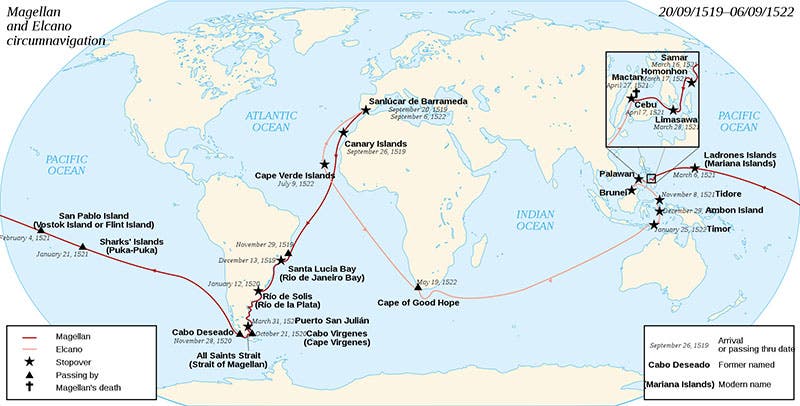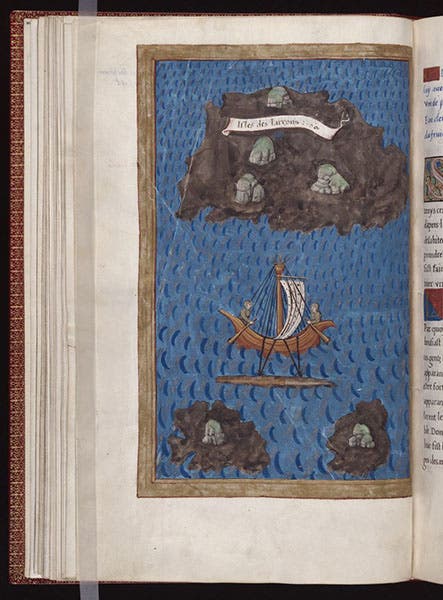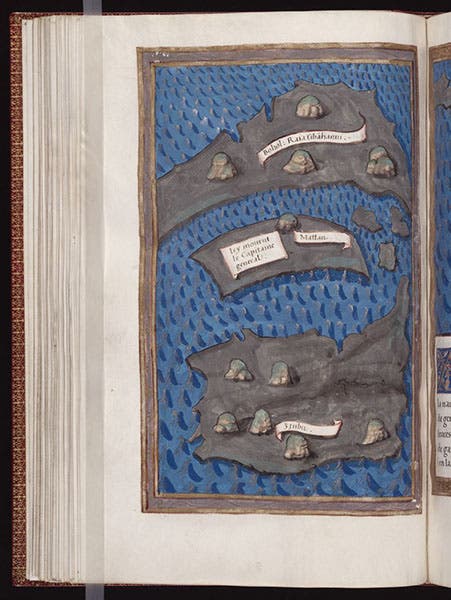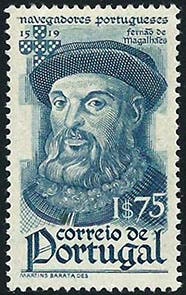Scientist of the Day - Ferdinand Magellan
Ferdinand Magellan, a Portuguese explorer and navigator, died violently on Apr. 27, 1521. Known as Fernăo de Magalhăes to the Portuguese, Magellan was not much of a scientist, but he was a heck of a navigator. He entered the service of King Manuel I of Portugal in 1495. He distinguished himself in the Portuguese conquest of Malacca on the Malaysian peninsula in 1511, acquiring valuable knowledge of the East Indies in the process, and getting to know Francisco Serrão, who would move to the Spice Islands and serve the Sultan of Ternate (the Isle of Cloves) in the Moluccas, and then provide further information to Magellan about sources for spices. Magellan tried to interest Manuel in sponsoring an expedition to find a trade route to the Spice Islands, but Manuel would not buy it. So in 1517, Magellan switched sides and proposed his expedition to the King of Spain. At the time, the Portuguese and Spanish had divided up the trade world between themselves, with Portugal controlling the routes around Africa, and Spain having dominion to anything west of the Atlantic. Magellan wanted to sail west, find a way across the Americas, and reach Asia that way. The Spanish were interested, since Magellan convinced the King that the Spice Islands lay in the Spanish hemisphere, rather than the Portuguese. Magellan had found his patron, and he set out in five small ships with a crew of perhaps 260 on Sept. 20 or 21,1519.
The voyage was eventful, to say the least. It took the flotilla a full year just to discover the entry to the Straits that would later be named after Magellan. Before he could attempt a Straits passage, he had to quell a mutiny by three Spanish captains and deal with the wreck of one ship, and the desertion of another. Then it took 37 days to navigate the Straits with the three remaining ships. But on Nov. 27/28, 1520, Magellan's fleet entered the Pacific. Magellan believed the voyage was nearly over, as he thought (as had Columbus) that the Earth was about 19,000 miles in circumference, which would put Asia just over the horizon. Instead, it took 111 painful days to cross the Pacific, as at least half the crew died of scurvy during the crossing. Magellan had headed west-northwest from South America, so he missed most of the peopled islands of the South Pacific. The first inhabited island they reached was Guam in the Marianas. When the natives stole a lifeboat and anything else they could find, Magaellan responded with an armed retaliatory party that killed some of the miscreants and retrieved the boat, thereby establishing a European pattern of encounter that would persist for several centuries.
Magellan's log has not survived, so nearly all we know about the events of Magellan's voyage comes from the diary of a supernumerary on board, Antonio Pigafetta, a well-educated Italian who signed on just for adventure. He not only kept a diary, but he adorned it with crude but compelling maps. He drew a map of the Straits of Magellan (second image), and he drew Guam and the Islas de los Ladrones (Isles of thieves), as Magellan called the Mariana Islands (fourth image). The map of the Ladrones is the only one of his 23 illustrations that shows native peoples, in this case sailing a catamaran. Four early manuscript copies of Pigafetta's journal survive, one in Italian and three in French translation. The finest of these is at the Beinecke Library at Yale, which is the source of our three Pigafetta maps (via, for some reason, the Library of Congress).
Magellan's next stop was the Philippines. After brief stays at Samar and Limasawa, they landed at Cebu, where Magellan successfully converted the rajah to Christianity. But the king of Mactan would have nothing to do with either Magellan or Christianity. When Magellan and his men tried to forcefully land on Mactan, they encountered a large army of bamboo-lance-equipped warriors right on the beach. Magellan was struck, and after he fell, repeatedly stabbed and killed. The king would not surrender his body. Magellan effectively disappeared from the face of the globe, and he would never reach the Isle of Cloves.
So Magellan never circumnavigated the world, which was not his intention anyway. But some of his crew managed to do so. Juan Elcano, one of Magellan’s pilots, and later promoted to captain of the Victoria, not only reached the Moluccas and filled the ship’s hold with cloves, but succeeded in sailing the Victoria across the Indian Ocean, around Africa, and back to Spain on Sep. 8, 1522, thus completing the first circumnavigation of the world. We told a little more of this part of the story in our post on Elcano.
There is not much in the way of physical remains of Magellan or his voyage. There are several portraits, but no contemporary ones – they were all painted long after his death. His flagship, the Trinidad, made it to the Moluccas (along with the Victoria), but it practically fell apart when they tried to leave, and was wrecked. Magellan’s log never made it back. There are some things named after Magellan – the Straits (for which he deserves full credit); the Magellanic clouds in the heavens, first spotted by the crew when in the Southern hemisphere (now known to be minor galaxies, satellites of the Milky Way); and the Magellanic penguin. It is often pointed out that Magellan was not a very nice man – he was brutal and arrogant, kept an indentured servant (slave) whom he forcefully acquired in Malacca (and who proved invaluable as a translator on the voyage), and killed enemies freely. And he was a traitor to boot. But still, to start in southern Chile, in three ships, each about 60 feet long and crammed with 60 unhappy and malnourished sailors, and head across a totally unknown Pacific, to find landfall in Guam and then the Philippines, that is really an amazing feat of both navigation and command presence. In that one Pacific crossing, Magellan totally reshaped European conceptions of the Earth, adding 6000 miles to its girth and destroying the Columbian notion (still very much alive in 1519) that the Americas were just the westernmost reaches of the Far East. As the man who really discovered the Pacific Ocean, he deserves more monuments than the few postage stamps that have been issued in his honor.
Dr. William B. Ashworth, Jr., Consultant for the History of Science, Linda Hall Library and Associate Professor emeritus, Department of History, University of Missouri-Kansas City. Comments or corrections are welcome; please direct to ashworthw@umkc.edu.

